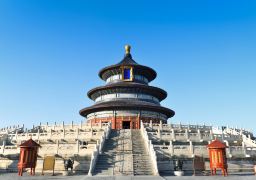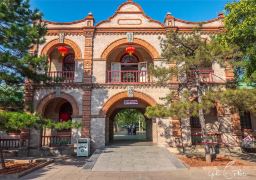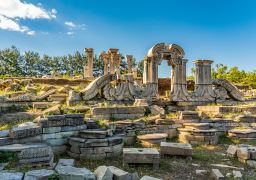Yangtai Mountain Natural Scenic Area is located in Bei’anhe Village, Sujiatuo Town, in the northwest of Haidian District. It is in the middle of the Haidian section of the historical and cultural belt of the Western Hills. It is 2.8 kilometers west of the Jingmi Diversion Canal and 15 kilometers away from the Summer Palace. The total area is 16 square kilometers. The Yangtai Mountain range stretches from north to south, and ravines run through from east to west. The main peak, Miaogaofeng, has an altitude of 1278 meters and is the highest peak in Haidian District. In spring (March to April), apricot blossoms, peach blossoms, pear blossoms, apple blossoms, and cherry blossoms in Yangtai Mountain open in succession. There are flowers everywhere, near and far, high and low. In summer, the spring water flows gurglingly, refreshing the eyes and purifying the mind. In autumn, colorful paintings are dazzling, and the forests are dyed layer by layer. In winter, snow presses on the green pines, and silver dragons dance. The scenic area has a wide variety of plant species and rich vegetation levels. Among them, ancient and famous trees account for 51.9% of those in Haidian District, and the vegetation coverage rate is as high as 90%. Since ancient times, Yangtai Mountain has been a natural scenic area. During the Zhangzong period of the Jin Dynasty, the Jinshui Courtyard (Jinshan Temple), Xiangshui Courtyard (Fayun Temple), and Qingshui Courtyard (Dajue Temple), which were famous among the ‘Eight Great Water Courtyards in the Western Hills’, were all in the area of Yangtai Mountain. Yangtai Mountain is a famous mountain in the suburbs of Beijing. In the Liao Dynasty, it was one of the eight great water courtyards in the Western Hills. During the Ming and Qing Dynasties and the Republic of China, Miaofeng Mountain held temple fairs from the first to the fifteenth day of the fourth lunar month. Tens of thousands of pilgrims reached the golden summit of Miaofeng Mountain along the ancient incense path of Yangtai Mountain. Now, many cultural relics and remains of ancient incense paths and tea sheds have been preserved. The green and secluded valley, backed by green mountains, features forests, springs, and temples.
Opening hours: Open from 07:30 to 17:00 from March 1st to October 31st; open from 08:00 to 17:00 from November 1st to February 28th. Peak season: March 1st to October 31st. Off-season: November 1st to February 28th. Preferential policies: Supplementary note: 1. There are currently no other preferential policies. 2. The above information is for reference only. Specific information should be subject to the disclosure on the day at the scenic area.Yangtai Mountain Natural Scenic Area
Yangtai Mountain Natural Scenic Area is located in Bei’anhe Village, Sujiatuo Town, in the nor[...]









